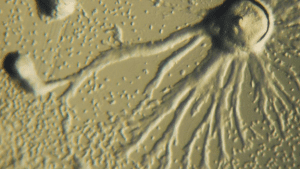TAG: GS 3: ECOLOGY AND ENVIRONMENT
THE CONTEXT: Scientists have gained valuable new insights into natural altruism by studying the amoeba Dictyostelium discoideum recently.
EXPLANATION:
Altruism
- Altruism is a widespread phenomenon in nature, where individuals sacrifice their own interests for the benefit of others.
- This phenomenon is observed in various species, including worker honey bees, widow spiders, and meerkats.
- The question of how altruism emerges in these diverse forms has long been a subject of interest among scientists.
- Recent studies on the social amoeba Dictyostelium discoideum have provided valuable insights into the genetic mechanisms that underlie altruism in nature.
Green-Beard Genes
- Green-beard genes are a type of genetic mechanism that allows individuals to recognize and cooperate with each other based on their genetic identity.
- These genes encode a tag that helps the genome to identify self-recognition, which in turn leads to altruistic behavior.
- In the context of D. discoideum, green-beard genes have been identified as crucial for the emergence of altruism.
- The findings demonstrate the logic that green-beard genes use to produce altruism plus the corresponding ability to keep altruistic amoebae from being exploited by greedy ones.
- The British-Indian geneticist is reputed to have said that he would jump into a river to save eight cousins but not seven — but also that he would jump in to save two brothers, yet not one.
- His quip highlights the fact that we share one-half of our genes with a sibling and one-eighth with a first-cousin.
Social Amoeba Dictyostelium Discoideum
- discoideum is a free-living, fast-growing, unicellular amoeba that feeds on bacteria.
- In the wild, it feeds on bacteria that grow on decaying vegetation.
- In the laboratory, researchers have been known to feed them a bacterial ‘lawn’ grown in a Petri dish.
- When the bacteria run out, the amoebae stop multiplying and gather in the hundreds of thousands to form multicellular aggregates visible to the naked eye.
- The aggregates then transform into fruiting bodies, each a few millimeters tall.
- A fruiting body is composed of a slender stalk made of dead cells, and it holds aloft a droplet of spores.
- About 20% of the amoebae in an aggregate altruistically sacrifice themselves to form the stalk. The remaining 80% become the spores.

Dictyostelium discoideum bacteria
Risk of Cheaters
- Not all the amoebae in an aggregate necessarily share kinship.
- Some could be only distantly related, so the aggregates can potentially be genetic chimaeras — structures in which not all amoebae have the exact same genome.
- And when the genome differs, there is a risk that some strains may have found a way to ‘cheat’ and avoid becoming stalk cells, and as a result become represented in more than their fair share among the spores.
The Role of tgrB1 and tgrC1 Genes
- In 2017, researchers from the University of Manchester reported that two genes in the D. discoideum genome — called tgrB1 and tgrC1 — displayed all the properties one would expect in a green-beard gene.
- On May 11 this year, researchers at the Baylor College of Medicine reported evidence that D. discoideum amoebae use these genes to navigate the risk of chimerism.
Function of tgrB1 and tgrC1 Genes
- The tgrB1 and tgrC1 genes are located next to each other in the D. discoideum genome, and are expressed together.
- They contain information for cells to make two cell surface proteins called TgrB1 and TgrC1.
- The TgrB1 protein on one cell binds to the TgrC1 protein on another. If the binding is strong, the TgrB1 protein is activated, and confers altruistic behavior — manifesting as the amoeba’s willingness to form the stalk.
- The binding between the TgrB1 and the TgrC1 proteins of cells of the same strain is strong, and leads to self-recognition and cell-cell cooperation.
- Pure cultures of cells that lack the tgrB1 and tgrC1 genes fail to develop because they are unable to recognize each other as being alike.
- The tgrB1 and tgrC1 genes are also very polymorphic: within the same population of D. discoideum amoebae, they have multiple variants.
- In fact, they are among the most variable genes in the Dictyostelium genome. When the researchers in the 2017 study examined 20 strains of the amoeba isolated from a common location, they found 18 different variants of each gene.
Correlation Between tgr Gene Sequences and Cell Segregation
- The researchers were able to correlate differences in the tgr gene sequences between two strains to the efficiency with which their cells segregated from each other in mixed aggregates and formed separate fruiting bodies.
- Specifically, when the binding of TgrB1 and TgrC1 proteins across the cells of diverged strains was weak, TgrB1 failed to be activated, and the cells split away from each other instead of cooperating.

